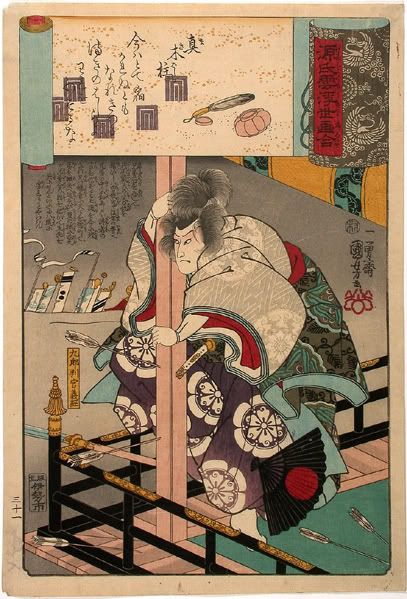From:
http://www.viewingjapaneseprints.net/texts/ukiyoetexts/ukiyoe_pages/kuniyoshi3.html
When the Tenpô reforms of 1842 banned prints of beautiful women and kabuki actors, prints depicting warriors and legends became the life-blood of artists like Kuniyoshi. As a result he issued several large series of warrior prints in the 1840s. Yet even historical subjects could prove dangerous if treated in the wrong manner. In 1843, when Kuniyoshi designed a very popular satirical triptych of the shogun Tokugawa Ieyoshi and the earth spider, the woodblocks and remaining stocks of unsold prints were confiscated and destroyed, and Kuniyoshi was investigated and officially reprimanded.
The illustration shown here is from one of the series issued while the Tenpô Reforms were still casting a shadow over print production. Titled and shown below, Genji kumo ukiyo-e awase ("A Comparison of Prints of the Floating World with the Cloudy Chapters of Genji"), it was published by Iseya Ichibei circa 1845-46. The series is apparently complete in 60 known designs, 54 for each chapter in the Genji monogatari ("Tale of Genji") plus 6 supplemental designs. The current design is number 31 (indicated in the lower left margin) corresponding to the Makibashira ("The Cypress Pillar") chapter, with its title shown in the middle of the scroll above, and the series title appearing at the top right on the scroll cover. The Genji-kô (Genji incense emblem) for chapter 31 is shown as a repeated pattern on the scroll surrounded by a poem. A descriptive text by Hanagasa Karitsu appears below the scroll at the far left.
After the great victory on April 25, 1185 at Danoura in which Minamoto no Yoritomo and his half brother Yoshitsune defeated the Taira clan, Yoritomo, who would be designated as the first shogun of Japan, became unjustly suspicious and jealous of the brilliant military exploits of his younger brother. He refused to allow Yoshitsune entry into the headquarters in Kamakura, and instead sent him off to Horikawa in Kyoto. Yoritomo then secretly dispatched a warrior monk named Tosabô Shôshun to assassinate Yoshitsune. The attackers were defeated and Shôshun was captured and beheaded by the legendary Benkei, the warrior priest and ally of Yoshitsune. From then on Yoshitsune took flight from his murderous brother, only to be ultimately forced to commit 'seppuku' (ritual suicide) rather than be captured in a final battle at Koromogawa on May 16, 1189.
The scene in Kuniyoshi's print depicts Kurô Hangan Yoshitsune as he grasps a pillar on the balcony of the palace at Horikawa. This gesture represents an obvious pictorial pun on the cypress pillar of the Genji chapter. It also connects Yoshitsune with the metaphorical meaning of "big size" used commonly in traditional Japanese poetry for the title word 'makibashira'. At the far middle left there are military banners rising through the mist, which belong to Tosabô Shôshun and his warriors. The heroic figure of Yoshitsune standing on the railing and defiantly observing his attackers while arrows strike all around him makes this one of the more successful designs from the series. ©1999-2001 by John Fiorillo
Monday, February 25, 2008
Kuniyoshi: Outlaw Artist Spirit
Subscribe to:
Post Comments (Atom)






No comments:
Post a Comment